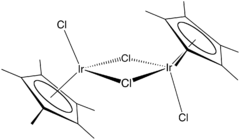- Pentamethylcyclopentadienyl iridium dichloride dimer
-
Pentamethylcyclopentadienyl iridium dichloride dimer  Di-µ-chloro-bis[chloro(pentamethylcyclopentadienyl)iridium(III)]Other namesDichloro(pentamethylcyclopentadienyl)iridium(III)
Di-µ-chloro-bis[chloro(pentamethylcyclopentadienyl)iridium(III)]Other namesDichloro(pentamethylcyclopentadienyl)iridium(III)Identifiers CAS number 12354-84-6 
Properties Molecular formula C20H30Cl4Ir2 Molar mass 796.71 g/mol Appearance orange solid Melting point >230 °C
 iridium dichloride dimer (verify) (what is:
iridium dichloride dimer (verify) (what is:  /
/ ?)
?)
Except where noted otherwise, data are given for materials in their standard state (at 25 °C, 100 kPa)Infobox references Pentamethylcyclopentadienyl iridium dichloride is an organometallic compound with the formula [(C5(CH3)5IrCl2)]2, commonly abbreviated [Cp*IrCl2]2 This bright orange air-stable diamagnetic solid is a reagent in organometallic chemistry.[1]
Preparation, structure, reactions
The compound has C2h symmetry. Each metal is pseudo-octahedral. It was first prepared by the reaction of hydrated iridium trichloride with hexamethyldewar benzene.[2] More conveniently, iridium trihydrate and pentamethylcyclopentadiene consistently gives the product in both high yield and purity according to this idealized equation:[1]
- 2 Cp*H + 2 IrCl3(H2O)3 → [Cp*IrCl2]2 + 2 HCl + 6 H2O
The two Ir-μ-Cl bonds are labile and can be cleaved to give a variety of adducts of the general formula Cp*IrCl2L. Such adducts undergo further substitution to afford cations [Cp*IrClL2]+ and [Cp*IrL3]2+. The chloride ligands can also be replaced by other anions such as carboxylates, nitrite, and azide.
Reduction of [Cp*IrCl2]2 under an atmosphere of CO affords the dicarbonyl Cp*Ir(CO)2], which can be decarbonylated to give the unsaturated derivative [Cp*Ir(CO)]2.[3] Treatment of [Cp*IrCl2]2 with borohydride under an atmosphere of H2 gives the iridium(V) derivative Cp*IrH4.
[Cp*IrCl2]2 is a precursor to catalysts for the asymmetric transfer hydrogenation of ketones.[4]
References
- ^ a b White, C.; Yates, A.; Maitlis, P. M. (1992). "(η5-Pentamethylcyclopentadienyl)Rhodium and -Iridium Compounds". Inorganic Syntheses 29: 228–234. doi:10.1002/9780470132609.ch53.
- ^ Jung W. Kang; K. Moseley; Peter M. Maitlis (1969). "Pentamethylcyclopentadienylrhodium and -iridium halides. I. Synthesis and properties". Journal of the American Chemical Society 91: 5970. doi:10.1021/ja01050a008.
- ^ R. G. Ball; W. A. G. Graham; D. M. Heinekey; J. K. Hoyano; A. D. McMaster; B. M. Mattson; S. T. Michel (1990). "Synthesis and structure of dicarbonylbis(.eta.-pentamethylcyclopentadienyl)diiridium". Inorganic Chemistry 29: 2023. doi:10.1021/ic00335a051.
- ^ Ikariya, T.; Blacker, A. J. (Dec 2007). "Asymmetric transfer hydrogenation of ketones with bifunctional transition metal-based molecular catalysts". Accounts of Chemical Research 40 (12): 1300–8. doi:10.1021/ar700134q. ISSN 0001-4842. PMID 17960897.
Categories:- Metallocenes
- Organoiridium compounds
Wikimedia Foundation. 2010.
